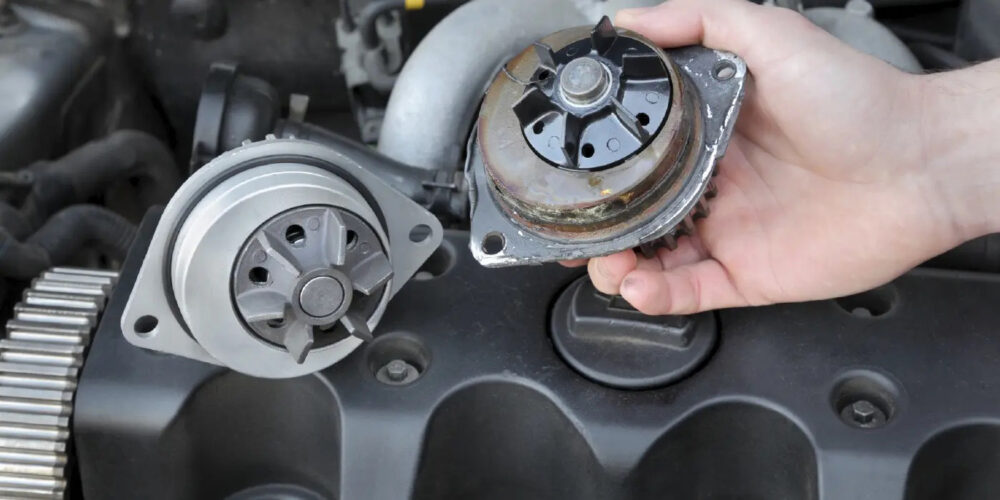Read up on essential products in our annual technical sales seminar section. We review 12 products you need to know better to move products.
Brakes
Fuel Pumps
Gaskets
Batteries
Wipers
Catalytic Converters
Shocks
Engine Management
Lighting
Belts and Hoses
Oxygen Sensors
Antifreeze
Don’t blow a gasket! Have you ever said that to someone who is really hot about something? The same advice also applies to engines. An engine that’s running too hot may blow its head gasket.
 The head gasket seals the gap between the cylinder head and block. The gasket keeps compression in the cylinder, and coolant out of the cylinder. The gasket is designed to handle the stresses and loads placed on it as a result of normal driving and the engine’s thermal cycles. But if the engine runs abnormally hot for a period of time, the gasket is in danger of being crushed or cracked.
The head gasket seals the gap between the cylinder head and block. The gasket keeps compression in the cylinder, and coolant out of the cylinder. The gasket is designed to handle the stresses and loads placed on it as a result of normal driving and the engine’s thermal cycles. But if the engine runs abnormally hot for a period of time, the gasket is in danger of being crushed or cracked.
The thinnest parts of the head gasket are most at risk for thermal failure. These are usually the areas between adjacent cylinder bores. If the exhaust ports on adjacent cylinders are “Siamesed” or right next to each other (like those on older small block Chevy V8s), heat can concentrate in this area and form a hot spot. If the heat gasket is not reinforced in this area, it may crush and fail.
When a hot spot has damaged the head gasket, the gasket may not start to leak until after the engine has cooled down and is restarted. Because the thickness of the head gasket has been compressed in the area of the hot spot, it may no longer maintain a tight seal. This can result in compression leaks or coolant leaks or both depending on the location of the damage. If the gasket is leaking coolant internally, the coolant level will slowly drop and eventually the engine will overheat.
If an engine is losing coolant and there are no visible leaks (radiator, water pump, hoses, freeze plugs, heater core or intake manifold gasket), the most likely cause would be a leaky head gasket. Such a leak can be verified by checking the oil dipstick for the presence of coolant or sludge in the oil, or by pressure-testing the cooling system. If the system can’t hold pressure for 15 minutes, the head gasket is likely leaking.
Replacing a head gasket is an expensive and time-consuming repair because of all the labor that’s required to pull the cylinder head and reinstall it. The cheap fix is to see if a bottle of cooling system sealer will temporarily seal the leak. There are a variety of such products available, and most are capable of sealing minor coolant leaks in a head gasket. But how long will such a repair last? A few weeks? Six months? A year? Nobody can say. Also, cooling system sealer cannot stop compression leaks. Because of these limitations, the recommended fix is to replace the head gasket.
A new head gasket will reseal the engine, provided the cylinder head (and block) are smooth, flat and clean. If the cylinder head is warped as a result of overheating, the head won’t load the gasket evenly when the head bolts are tightened down. This may prevent the gasket from sealing, or result in a repeat gasket failure at some point in the future. Checking the flatness and surface finish of the head and block can prevent such problems.
Most head gaskets are not reusable — even multi-layer steel (MLS) head gaskets. If the cylinder head is removed from the engine for any reason, the head gasket needs to be replaced.
Most head gaskets are installed dry (except for some older embossed steel head gaskets that may require sealer), and sealer should never be used on a soft-face or coated head gasket.
A customer who is replacing a head gasket also will need the other upper engine gaskets, too, including new valve cover, intake and exhaust manifold gaskets. A head gasket set will usually include all the gaskets and seals that are necessary to make the repair.
If the old head gasket does not come off cleanly, it may be necessary to use some aerosol gasket remover and/or a scraper. Care must be used not to scratch the surface of the block or head. Abrasives should never be used to clean off gasket residue as this may leave a depression in the surface that could cause a leak.
Many late model engines use Torque-to-Yield (TTY) head bolts. The bolts are designed to stretch when tightened, and should not be reused (they may break if used a second time). If the replacement head gasket set does not include new TTY bolts (and the engine requires them), make sure your customer gets a new set of head bolts.











